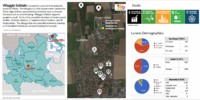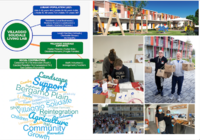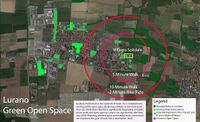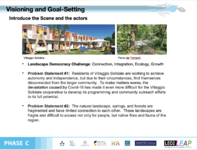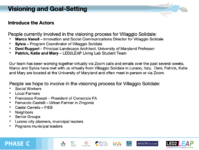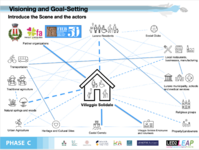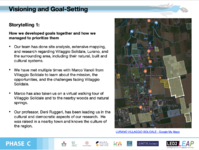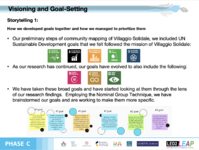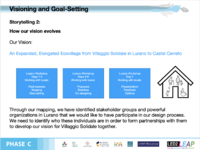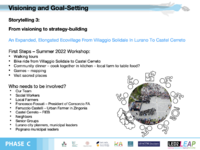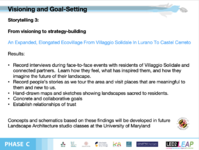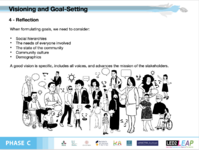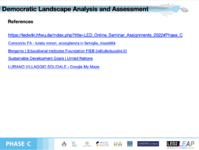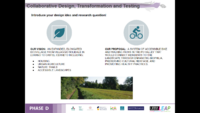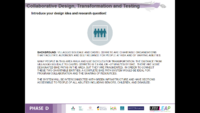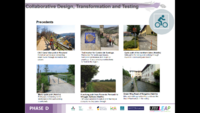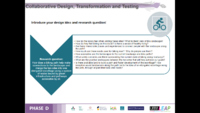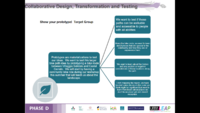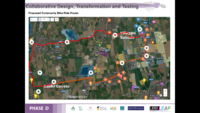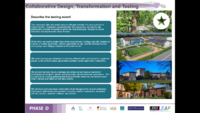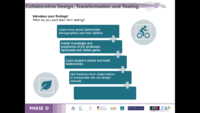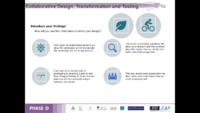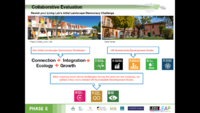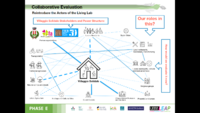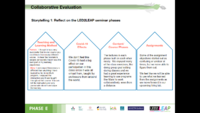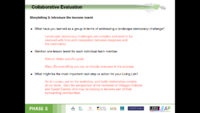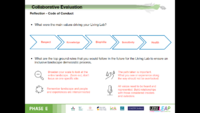Lurano Living Lab
>>>back to working groups overview
For help with editing this Wiki page use this link.
For more details on assignments and key readings please use this link.
| Area | Villaggio Solidale | |
| Place | Lurano | |
| Country | Italy | |
| Topics | Urban Agriculture, Self-Reliance, Ecology | |
| Author(s) | Patrick Boyle, Mary Christensen | |
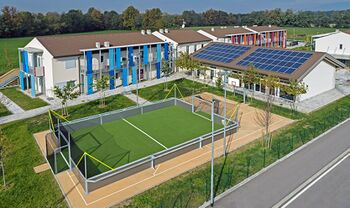
| ||
Landscape Democracy Rationale
- Villaggio Solidale is a commune, housing destressed people looking to make their lives better through autonomy training specifc to the needs and restraints of the individual. This community is isolated on the outskirts of the town and new to operations. Established in 2018, more than half of its time open has been during the COVID-19 Pandemic, which has isolated the community far beyond its physical limitations and stunted its growth. Consorzio FA, its managing counterpart, is eager to expand and grow programming for the community members living at and associated with Villagio Solidale. Support from the larger community and integration with them is of great importance in the successful transition of the residents to a self-reliant lifestyle.
Connecting Villagio Solidale to Lurano
- You can edit this map with the map editor Special:MapEditor
Phase A: Mapping Your Community
Welcome to Your Community and Their Landscape
Villagio Solidale is located in Lurano, Italy in the region of Lombardy. Lurano is just 10 miles south of Bergamo and 30 miles east of Milan. Within Lurano, Villagio Solidale is on the northern edge of town near a natural spring and nature preserve, that represents remnants of a dominant wetland in the region. Surrounding the small town of Lurano (pop. ~2,800) are agricultural fields and commercial greenhouses. The town center, walking distance from Villaggio Solidale, is where the residents go for church and school, there is also a sports field, playground, and a bus station. Looking at the demographics, about 90% of the town is made up of Italian nationals while to other 10% are forneigners with Afrian descendents making up 6% of them. The Villaggio Solidale, as part of their mission, helps some of these foreigners that are in need of refuge. In supporting these people and others need, they are achieving goals layed out by the United Nations. Those goals identified in their mission statement are Decent Work and Economic Growth, Good Health & Well-being, Life on Land, Partnership for the Goals, and Sustainable Cities and Communities.
Groups of Actors and Stakeholders in Your Community
The University of Maryland Living Lab Team began to think about how the community of Lurano is structured and who the major groups are within the town. If they are to engage with the community they need to know who to reach out to and make assumptions on how these groups may interact. For the residents of Villaggio Solidale to become more integrated into the greater community, introducing these groups to the village's mission would be a good way to begin. By revealing similaries in each group's goals, connections can be made, partnerships can begin to form to achieve like goals, and relationships can grow. Connections were thought of not only at an orgainzation level, but also how individuals could begin to make relationships. By understanding who the residents of the villaggio are we can better understand the restrictions they may have to make these connections. The residents are both youth and adults, some having more freedom than others depending on their guardians and physical contraints. It is important to know the reach the residents have to the community to form these relationships. This thought process made it more apparent that interest in the greater community to begin socializing closer to the villaggio would be of great importance to their integration.
Relationships Between Your Actors and Groups
Consorzio FA, the controlling non-profit of Villaggio Solidale has many relationships in the region of Bergamo. New to Lurano they are trying to strengthen bonds with local groups, especially interested in the reitred population. They hope to partner with the retired persons community organization to recruit volunteers to help with antonomy training. These relationships have been put on hold because of the vulnerbility of the elderly during the COVID-19 Pandemic, but want to rekindle old relationships and make new ones so that these persons can share their wisdom and wealth of knowledge with the residents of Villaggio Solidale. There are also many other non-profit organizations that do similar work and their goals aline that they could potentially work with in the future growth of the commune.
Summary of Your Learnings from the Transnational Discussion Panel
Our graphics had potential and individually gave good information, but the story became lacking with the layout. We hope to make strides in graphic design to help communicate our message better.
Theory Reflection
This project has much potential to practice landscape democracy. The fragile families that live here need to be heard and their needs are very specific. Listening to them and promting questions about relationships of the community will reveal much more about the actors at play in Lurano and Bergamo at large.
References
- https://www.unsustainabledevelopmentgoals.org/
- https://www.consorziofa.it/villaggio-solidale/
- https://www.tuttitalia.it/lombardia/88-lurano/statistiche/popolazione-andamento-demografico/
- https://maps.google.com/
Phase B: Democratic Landscape Analysis and Assessment
Connecting Villagio Solidale to Greater Lurano through Bike Accessibility and Green Spaces: Patrick Boyle
My Stance is to expand green spaces to the north part of town near Villagio Solidale for public use making it a destination for community members and in part increase awareness of the villagio and integrate its residents into the larger community. The map indicates different uses of open space around the town of Lurano. In dark green, there are remnascants of a prehistoric forest, now under preservation by neighboring municipalities. This park has springs of water that are a great natural resource for recreation or irrigation for the greater community as well as the residents of villiggio. By revitilzing these forests and making the agricultural land that fragments the area more productive this landscape can be an immense resource for atonomy training for Villaggio Solidale. There are many vacant lots and even a small parklet within walking distance of the villaggio that could be enhanced to draw both residents of the town and the villaggio where they can form relationships.
Your Name and title of your personal title
- Addyouruniqueimagename.jpg
insert text here
- Addyouruniqueimagename.jpg
insert text here
Phase C: Collaborative Visioning and Goal Setting
The Scene in Your Story of Visioning
Two challenges have arose during our research of Villaggio Solidale and Lurano. We have come to find out that the region of Bergamo was one of the most hard hit places, globally, during the COVID-19 Pandemic. The connections and relationships needed for the residents to thrive has been hindered. Programs to build self-reliance and knowledge for job developement and education are have not been able to raise to their full potential. Also, the Parco dei Fontanili forest system is extremely fragmented with agricultural land, much of which seems to be unused leaving acres of potential land for new growth, productive organic or localized agricultural, and recreational use. This year Italy has struggled with one of the worst draughts in the last century making this landscape even more fragile as we struggle with climate change.
The Actors in Your Story of Visioning
We have a team working together at-a-distance exchanging information over Zoom. This team consists of students and their professor at University of Maryland and employees of Consorzio Fa including the Director and Coordinator of Social Programming. This exchange occured on a bi-weekly basis where the student team developed a relationship with the coordinator. The coordinator provided us with statements from residents about their daily lives, an audio-visual tour of the grounds where to begin to understand the layout, how the residents used the public spaces, the relationship between residents, and the connection to the forest preserve.
The Story of Visioning
Reflect on Your Story of Visioning
Working remotely on a site unfamiliar to us was a challenge, not only because we couldn't interact with the landscape, but also because of the language barrier. We used Google Mymaps to study the landscape and pull as much contextual information about the local region as we could. We looked at zoning, institutions, businesses, industries, and cultural landmarks. We then took this information a step further by researching their relevance, making connections between the diverse places. We used a goal setting system to determine the importance of goals introduced and looked at specifying goals down to their activation details. Its tough to implement landscape democracy, but it is thorough and the final product has more meaning to the community and the people who be experiencing the landscape.
Phase D: Collaborative Design, Transformation and Planning
Your Prototyping Action
- insert text here
The Evolution of Your Prototyping Action
- insert text here
The Plan Behind Your Prototyping Action
- insert text here
The Realization of Your Prototyping Action
- We have a workshop planned in late August 2022 where we will test the prototype and engage with the community.
Reflect on Your Prototyping Action
- insert text here
Phase E: Collaborative Evaluation and Future Agendas
Collaborative Evaluation and Landscape Democracy Reflection
- insert text here
The Actors in your Collaborative Evaluation
- insert text here
Reflection on the Online Seminar
- insert text here
Reflection on your Living Lab Process
- insert text here
Your Living Lab Code of Conduct
- insert text here
Process Reflection
- insert text here
